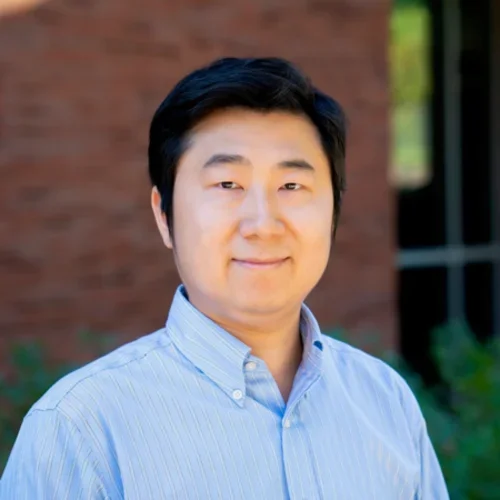
Weizhe Hong, PhD
Professor
CHS 77-200K
650 Charles E Young Dr. S.
Los Angeles, CA 90095
About
Dr. Hong is a Professor of Neurobiology, Biological Chemistry, and Bioengineering at the University of California Los Angeles. His research aims to uncover the fundamental neural mechanisms underlying social behavior, with a specific focus on empathy and prosociality. Dr. Hong earned his PhD degree in 2012 from Stanford University and was a Helen Hay Whitney Postdoctoral Fellow at the California Institute of Technology. In 2016, he joined UCLA as Assistant Professor, and he was promoted to Associate Professor with tenure in 2020 and to Full Professor in 2023. He is also the recipient of a Young Investigator Award from the Society for Neuroscience, an Early Career Award from the Society for Social Neuroscience, a Mallinkrodt Scholar Award, a Vallee Scholar Award, a Searle Scholar Award, a Packard Fellowship in Science and Engineering, a McKnight Scholar Award, a Klingenstein-Simons Fellowship, and a Sloan Research Fellowship.
Publications
- Zhang M, Wu YE, Jiang M, Hong W. (2024) Cortical regulation of helping behavior toward others in pain. Nature. 626, 136–144
- Phi NT, Yu X, Hong W. (2023) Control of social hierarchy beyond neurons. Nature Neuroscience. 26, 1485-1486
- Wu YE, Hong W. (2022) Neural basis of prosocial behavior. Trends in Neurosciences. 45, 749-762
- Wu YE, Dang J, Kingsbury L, Zhang M, Sun F, Hu RK, Hong W. (2021) Neural control of affiliative touch in prosocial interaction. Nature. 599, 262-267
- Hu RK, Zuo Y, Ly T, Wang J, Meera P, Wu YE, Hong W. (2021) An amygdala-to-hypothalamus circuit for social reward. Nature Neuroscience. 24, 831-842
- Raam T, Hong W. (2021) Organization of neural circuits underlying social behaviors: a consideration of the medial amygdala. Current Opinion in Neurobiology. 68, 124-136
- Kingsbury L, Huang S, Raam T, Ye LS, Wei D, Hu RK, Ye L, Hong W. (2020) Cortical representations of conspecific sex shape social behavior. Neuron. 107, 941-953
- Kingsbury L, Hong W. (2020) A multi-brain framework for social interaction. Trends in Neurosciences. 43, 651-666
- Kingsbury L, Huang S, Wang J, Gu K, Golshani P, Wu YE, Hong W. (2019) Correlated neural activity and encoding of behavior across brains of socially interacting animals. Cell. 178, 429-446
- Chen PB, Hu RK, Wu YE, Pan L, Huang S, Micevych PE, Hong W. (2019) Sexually dimorphic control of parenting behavior by the medial amygdala. Cell. 176, 1206-1221
- Hong W. (2018) Understanding social behavior—setting the stage for the next generation of neuroscience. Neuron. 99, 11-12 (Neuron Voices)
- Chen P, Hong W. (2018) Neural circuit mechanisms of social behavior. Neuron. 98, 16-30
- Wu YE, Pan L, Zuo Y, Li X, Hong W. (2017) Detecting activated cell populations using single-cell RNA-seq. Neuron. 96, 313-329
- Hong W, Kennedy A, Burgos-Artizzu XP, Zelikowsky M, Navonne SG, Perona P, Anderson DJ. (2015) Automated measurement of mouse social behaviors using depth sensing, video tracking, and machine learning. Proc. Natl. Acad. Sci. USA. 112, E5351-5360
- Ward A*, Hong W*, Favaloro V, Luo L. (2015) Toll receptors instruct axon and dendrite targeting and participate in synaptic partner matching in a Drosophila olfactory circuit. Neuron. 85, 1013-1028 (*co-first authors)
- Hong W, Kim DW, Anderson DJ. (2014) Antagonistic control of social versus repetitive self-grooming behaviors by separable amygdala neuronal subsets. Cell. 158, 1348-1361
- Hong W, Luo L. (2014) Genetic control of wiring specificity in the fly olfactory system. Genetics. 196, 17-29
- Hong W. (2013) Assembly of A Neural Circuit. Science. 342, 1186
- Mosca TJ*, Hong W*, Dani VS, Favaloro V, Luo L. (2012) Trans-synaptic Teneurin signaling in neuromuscular synapse organization and target choice. Nature. 484, 237-241 (*co-first authors)
- Hong W, Mosca TJ, Luo L. (2012) Teneurins instruct synaptic partner matching in an olfactory map. Nature. 484, 201-207
- Hong W*, Wu YE*, Fu X, Chang Z. (2012) Chaperone-dependent mechanisms for acid resistance in enteric bacteria. Trends in Microbiology. 20, 328-335 (*co-first authors)
- de Wit J*, Hong W*, Luo L, Ghosh A. (2011) Role of leucine-rich repeat proteins in the development and function of neural circuits. Annual Review of Cell and Developmental Biology. 27, 697-729 (*co-first authors)
- Hong W, Zhu H, Potter CJ, Barsh G, Kuruzu M, Zinn K, Luo L. (2009) Leucine-rich repeat transmembrane proteins instruct discrete dendrite targeting in an olfactory map. Nature Neuroscience. 12, 2542-2550
- Wu YE*, Hong W*, Zhang L, Liu C, Chang Z. (2008) Conserved amphiphilic feature is essential for periplasmic chaperone HdeA to support acid resistance in enteric bacteria. Biochemical Journal. 412, 389-397 (*co-first authors)
- Hong W, Jiao W, Hu J, Zhang J, Liu C, Fu X, Shen D, Xia B, Chang Z. (2005) Periplasmic protein HdeA exhibits chaperone-like activity exclusively within stomach pH range by transforming into disordered conformation. Journal of Biological Chemistry. 280, 27029-27034